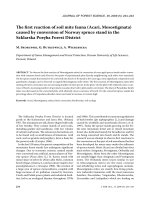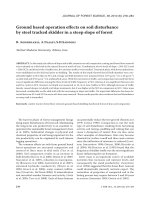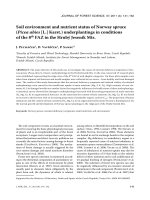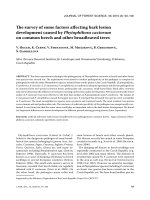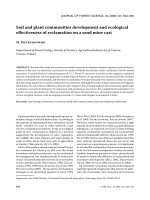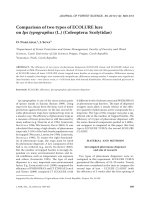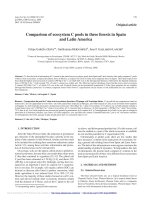Báo cáo lâm nghiệp: "Soil compaction caused by 450C Timber Jack wheeled skidder (Shefarood forest, northern Iran)" doc
Bạn đang xem bản rút gọn của tài liệu. Xem và tải ngay bản đầy đủ của tài liệu tại đây (197.23 KB, 6 trang )
314 J. FOR. SCI., 53, 2007 (7): 314–319
JOURNAL OF FOREST SCIENCE, 53, 2007 (7): 314–319
The northern forests of Iran with 1.9 million
hectares are very important for their capability of
producing timber and 1.3 mill ha of these forests are
commercial. e forests border the southern coast of
the Caspian Sea in a narrow strip which has special
ecological and topographical conditions and also has
exclusive plant species diversity.
In recent years the demand for wood has increased
because of the population increase and diversity
use of wood, and so it is necessary to harvest these
forests in a methodical plan with the knowledge of
different elements of harvesting, so that harvesting
and efficiency are increased, but at the same time
maintaining the natural balance of forest by not en-
dangering the soil, plant and animal life.
On this basis, with the disappearance of traditional
harvesting and the need for suitable forest mechani-
zation systems, it is essential to transform the forest
harvesting sector. One of these transformations is
the use of suitable machinery with high efficiency.
e 450C Timber Jack skidder that has been import-
ed from Canada in recent years is one of the machines
used for a ground-based skidding system in order to
extract logs from the stump area to roadside land-
ing. e use of machinery in different environmental
conditions (i.e. climate, topography and different type
of soils) has diverse effects which can sometimes be
destructive and cannot be compensated.
It is obvious that the skidder traffic and the extrac-
tion of wood cause soil compaction on the forest soil
surface and because of this the soil water infiltration
and aeration decrease and root growth will also be
affected. erefore the loading or in other words
the traffic on soil must be specified, otherwise soil
compaction will be destructive and will not be eco-
nomically and technically compensable.
e amount of soil compaction is affected by the
weight of machinery and load, number of machinery
passes, resistance and hardness of the forest floor,
soil structure, soil texture and soil moisture content
(A, F 1981). e effect of machine
traffic on soil will increase the soil wet bulk density
and shear strength, decrease porosity and water and
air infiltration (D et al. 1993).
Soil compaction caused by 450C Timber Jack wheeled
skidder (Shefarood forest, northern Iran)
R. N
1
, I. B
1
, M. A
2
, A. M
3
1
Department of Forestry, Faculty of Natural Resources, e University of Guilan, Sowmehsara, Iran
2
Department of Soil Science, College of Agriculture, e University of Guilan, Rasht, Iran
3
Department of Forestry, Faculty of Agriculture, University of Ilam, Ilam, Iran
ABSTRACT: In forest harvesting operations usually after using skidding machinery (skidders), traces of soil damage in
the form of soil compaction and wheel and logs ruts can be seen in the forest soil. Soil bulk density, which represents soil
compaction, decreases soil porosity, infiltration rate and aeration and these in turn increase runoff and water erosion
in the harvested area. On the other hand, a decrease in soil aeration prevents root growth and decreases the vegetative
cover. In this study the changes in soil bulk density and relative soil compaction due to a different number of wheeled
skidder passes from stump to landing for two soil types (clay soil with high and low liquid limits, CH, CL) are analyzed.
e results showed that the effect of skidder traffic on an increase in soil bulk density at sample locations was signifi-
cant (α = 0.05). e range of soil bulk density increases in sample pits due to a different number of machinery passes
was from 15.8% to 62.6% compared to the control area. e findings of this research showed that the interaction effect
of skidder traffic and soil type on soil bulk density changes was not significant. Also the highest significant increase in
soil bulk density occurred at the first 11 passes in skidding trails and from this number of passes onwards there was no
significant difference in the soil bulk density increase in sample locations.
Keywords: soil compaction; forest soil; wheeled skidder; Iran
J. FOR. SCI., 53, 2007 (7): 314–319 315
In a study carried out by J and J
(1998), the effect of wheeled and tracked machinery
was studied on soil bulk density in silt loam soil in
Sweden. e results showed that average bulk den-
sity increased 23% and 14% at 15 and 20 cm depth,
respectively, after two passes of wheeled forwarder
machinery (20 ton weight). e traffic of wheeled
machinery at the first pass produces the highest
compaction in soil and the following machinery
passes have a lower effect, but overall soil compac-
tion is produced which significantly affects the root
growth (H et al. 1988). Studies by B
et al. (1985) showed that the number of machinery
passes significantly affects soil bulk density and the
soil bulk density of top soil increases very rapidly in
the first three passes and the following passes have
a lower effect.
Skidding operations are the most common way
of causing soil compaction (S, C
1997). The skidding machinery is designed and
manufactured in a way so that it can transport
heavy loads in off-road conditions. Hence a major
part of soil degradation occurs on skid trails and
landings due to skidding operations (H et
al. 2002). F and M (1984) came to
the conclusion that the initial few passes of skidder
have the highest compaction effect on soil. In other
words, the initial 5 passes exceptionally increase soil
compaction whereas the following passes cause less
soil compaction.
G et al. (1983) proved that in skidding opera-
tions using wheeled skidders, the severest compac-
tion occurred at 10 cm depth of soil and the effect of
compaction decreases with an increase in soil depth.
In skidding trails that were used a lot, the soil com-
paction was reported at 30 cm depth. B (1998)
showed that the increase in soil bulk density caused
by wheeled skidders in harvesting sites compared to
control sites was from 11% to 80% with average of
52% at 0–10 cm depth and 12% to 56% with average
of 34% at 10–20 cm depth.
In this research the destructive effects of wheeled
skidder in skidding trails on different soil types are
studied. With respect to this, the amount of soil
compaction from different machinery passes at
sample locations is measured and when to use the
machinery with respect to soil conditions.
MATERIALS AND METHODS
is research was carried out on parcel 925 and
926 of the ninth district of Shefarood forest in
northern Iran, at the altitude ranging from 1,300 to
1,600 m above sea level and average annual precipita-
tion of 1,100 mm. e forest was uneven-aged and its
type was Fagetum (Fagus orientalis Lipsky) with the
average growing stock 330 cubic meters per hectare.
e slope of the parcel was 20 to 50% and the aspect
of the slopes was northwest and west. e mineral
soil was covered with an organic layer approximately
5 cm thick. e moisture content during the experi-
ment was 29% at 15 cm depth. e parent material
is calcareous and the type of soil is leached brown
forest soil. e soil is clay and clay loam and deep,
with moderate to good root penetration.
e total volume of production was 2,800 m
3
and
the extraction of short and long logs from the stump
area to roadside landing was done by a ground-based
skidding system. e skidder type used in this study
was 450C Timber Jack cable skidder, model 6BTA5.9
with 177 hp and 10,257 kg weight.
In order to study the soil compaction due to differ-
ent machinery passes and therefore different volume
of wood being extracted along skidding trails, the soil
bulk density is determined by a field soil compaction
test. Using this method the amount of soil compac-
tion in skidding trails before any machinery passes
and during skidding operations is measured. e
soil samples were taken by an observation and field
sieve analysis method along skidding trails where
soil changes were expected in the form of texture
and soil particles. Hence the number of samples in
each skidding trail was different, in other words if the
soil along the trail was similar from the aspect of soil
texture and mechanical characteristics, the number
of soil samples was lower and if it was dissimilar, the
number of soil samples was higher.
In this study 10 locations along skidding trails were
chosen for the analysis of bulk density changes due
to different machinery passes and soil types. Sample
pits were dug in these 10 locations and with the use
of cylinder and standard sand, field soil compac-
tion tests were carried out. Each pit was 10 cm in
diameter and 15 cm in depth, the soil content of
which was used for determining wet bulk density,
percentage of moisture content and dry bulk density
at different machinery passes (before any machinery
passes in skidding trails, i.e. control pit, after the first
pass, after 6
th
pass, after 11
th
pass, after 16
th
pass,
after 21
st
pass and after the final pass).
e formulas below are used to determine the
above parameters:
weight of soil removed from pit × sand bulk density
wet bulk density = –––––––––––––––––––––––––––––––––––––––––
weight of sand poured in to the pit
weight of water
soil moisture content = –––––––––––––––––– × 100
weight of dry soil
316 J. FOR. SCI., 53, 2007 (7): 314–319
γ
w
γ
d
= –––––––
1 + w%
where: γ
d
– dry bulk density (g/cm
3
),
γ
w
– wet bulk density (g/cm
3
),
w% – moisture content percentage.
In this research a borehole was dug in each of the
sample location along skidding trails. erefore after
transferring the soil to the laboratory, the mechanical
properties of each location were determined. In the
soil samples transferred to the laboratory the sieve
analysis, Atterberg limit test and Proctor compac-
tion test were carried out. By carrying out Proctor
compaction test on the soil samples, the maximum
bulk density (γ
d max
) and optimum moisture content
needed for γ
d max
are determined. ese data are
used to analyze bulk density changes due to different
machinery passes at different moisture contents, and
then they are compared with the optimum moisture
content for soil compaction.
In this study in order to assess the effect of skid-
der traffic on soil bulk density changes (with the use
of data collected from the results of field compac-
tion test in sampling locations), the single factorial
ANOVA was used. For assessing the interaction
effect of two factors (skidder traffic and soil type),
the two-way factorial ANOVA was used. Finally
Newman-Keuls multiple range test was used to de-
termine at what number of skidder passes the high-
est significant increase in soil bulk density occurred
(Z 1974).
RESULTS AND DISCUSSION
With respect to the sieve analysis and Atterberg limit
test of 10 soil samples from the studied area and on the
basis of unified soil classification system (USCS), two
types of soils with different mechanical characteristics
were identified. Clay soil with high liquid limit (CH)
and clay soil with low liquid limit (CL) (Table 1).
The data obtained from sample pits showed
that the bulk density increase in comparison with
control pit at the first machinery pass is on aver-
age 18.2% (Table 2). Measuring the bulk density
after the 21
st
pass in the above sampling locations
showed that the bulk density increase in compari-
son with control sample location was on average
58.5%. With regard to the data from Proctor com-
paction test of soil samples obtained from bore-
holes in sampling locations, the analyses of changes
in optimum moisture content and maximum bulk
density were carried out in soil samples from dif-
ferent soil types (Table 3).
The analysis of soil bulk density from sample
locations, with the use of single factorial ANOVA,
showed that the effect of skidder traffic on an in-
crease in soil bulk density was significant (α = 0.05)
(Table 4). In general ground skidding operations
caused a significant increase in soil bulk density in
all skidding trails in the studied area.
e analysis of soil bulk density, with the use of
two-way factorial ANOVA, showed that the effect
of skidder traffic on soil compaction (with regard
Table 1. Summary of the soil mechanical test of 10 soil
samples from sample locations in skidding trails
Location
Liquid
limit
Plastic
limit
Plastic
indices
Soil type
1 49 11 38 CH
2 38 20 18 CL
3 41 20 21 CL
4 52 11 41 CH
5 37 17 20 CL
6 40 21 19 CL
7 52 12 40 CH
8 53 12 41 CH
9 44 18 26 CL
10 51 11 40 CH
Table 2. Results of the field soil compaction test at different pits from sample locations in skidding trails
Number of machinery passes
Average measurements
γ
d
(g/cm
3
) MC (%) ∆γ
d
(%)
Control pit 0.99 28.5 –
First machinery pass 1.18 27.6 18.2
6
th
machinery pass
1.32 28.1 33.6
11
th
machinery pass
1.47 27.9 47.7
16
th
machinery pass
1.57 27.1 57.5
21
st
machinery pass
1.58 29.5 58.5
Final machinery pass 1.59 30.2 59.6
γ
d
– average bulk density, MC – average moisture content, ∆γ
d
– average bulk density increase compared to control
J. FOR. SCI., 53, 2007 (7): 314–319 317
to soil type) was not significant. In fact the interac-
tion effects between the amount of compaction due
to skidder traffic and soil type were not significant
(Table 5). e comparison of mean soil bulk density
of the final pass with other passes (Newman-Keuls
test) also showed that there was a significant dif-
ference up to 11 passes. Furthermore, there was no
significant difference between the final pass and the
16
th
and 21
st
pass (Table 6).
Table 3. e results of the compaction test of soil samples
from a laboratory
Soil
sample
Soil
type
Maximum bulk
density (g/cm
3
)
Optimum moisture
content (%)
1 CH 1.65 23.9
2 CL 1.71 20.8
3 CL 1.65 24.7
4 CH 1.62 22.3
5 CL 1.63 19.8
6 CL 1.59 24.2
7 CH 1.69 23.1
8 CH 1.63 20.2
9 CL 1.59 23.4
10 CH 1.71 22.8
Table 4. Single factorial ANOVA
Source of variation df F P-value Critical F-value
Groups 6 987.47 P < 0.01 2.25
Error 63
Total 69
Table 5. Two-way factorial ANOVA
Source of variation df F P-value Critical F-value
Soil types 1 1.784 0.19 4.0
Skidder passes 6 984.28 P < 0.01 2.26
Soil types × skidder passes interaction 6 0.83 0.55 2.26
Error 56
Total 69
Table 6. Newman-Keuls multiple range test
Comparison of average γ
d
Difference SE q p q distribution Conclusion
B vs. A X^b–X^a
Final MP* vs. control pit 0.59 0.007 80.86 7 4.31 is rejected Ho: µ7 ≠ µ1
Final MP vs.1
st
MP 0.41 0.007 56.22 6 4.16 is rejected Ho: µ7 ≠ µ2
Final MP vs. 6
th
MP 0.27 0.007 36.21 5 3.98 is rejected Ho: µ7 ≠ µ3
Final MP vs. 11
th
MP 0.13 0.007 17.70 4 3.74 is rejected Ho: µ7 ≠ µ4
Final MP vs. 16
th
MP 0.02 0.007 2.59 3 3.40 not rejected Ho: µ7 = µ5
Final MP vs. 21
st
MP 0.007 0.007 0.95 2
*MP – machinery pass
In this research soil bulk density due to traffic
increased significantly and it was so because there
was a decrease in the volume of soil pores. Similar
results were reported by other researchers (B
et al. 1985; D et al. 1993; F, M
1984; H et al. 1988).
e results of this research and other researches
(B et al. 1985; B 1998; F, M
1984) showed that the highest bulk density increase
(soil compaction) occurred at initial passes and with
the increase in traffic the soil bulk density increase was
not significant. is study showed that the increase
in soil bulk density in skidding trails compared to the
control at different machinery passes and at 15 cm
depth is in the range of 15.8% to 62.6%. A and
F (1981) in their research showed that these
values with the use of skidding machinery were in the
range of 15% to 60% and that soil moisture was an ef-
fective factor of changing this range of limits.
e comparison of bulk density increase with the
control after the first machinery pass in sampling
locations confirmed that in locations where the
moisture content (natural m.c.) of pit was near to
optimum m.c., the percentage of bulk density in-
crease was higher. A et al. (1998) in their research
318 J. FOR. SCI., 53, 2007 (7): 314–319
showed that the optimum m.c. was an effective factor
of an increase in the compaction in skidding trails.
CONCLUSIONS
With reference to the aim of this research, it
must be stated that soil bulk density due to traffic
increased significantly and that the greatest soil
compaction occurred at the initial passes.
e effect of skidder traffic on soil compaction (in
relation to soil type) was not significant.
Considering the permissible number of machinery
passes and average amount of logs being carried at
each pass, the carrying potential of each skidding
trail can be estimated. Hence the amount of logs that
can be carried along a skidding trail can be chosen
so that machinery passes do not exceed the number
of permissible machinery passes and consequently
will not cause the soil destruction.
erefore in the time of planning the machinery
use (when to use machinery), it is important to stop
skidding operations on days when the soil moisture
content is close to the optimum m.c. In the studied
area the optimum m.c. usually occurred a few days
after rainfall and in these conditions machinery traffic
(passes) can increase the soil compaction in skidding
trails significantly. us the skidding operation after
the skidding trails having been completely dried up can
significantly decrease the extent of destructive effect.
ese conditions (m.c. lower than optimum m.c.)
occur very rarely in the northern forests of Iran and
with regard to the climate of the area, the soil natural
m.c. is at optimum and higher and the results of this
study verify that. erefore we cannot wait for days
when m.c. is lower than optimum because in practice
m.c. is at optimum and higher.
Hence skidding operations can be carried out at
m.c. higher than optimum m.c. (a few days after
rainfall) provided that the m.c. of skidding trails is
not saturated, otherwise the soil will be damaged.
Ref erence s
ADAMS P.W., FROEHLICH H.A., 1981. Compaction of forest
soils. USDAFOR Service. Pacific North West.
AUST W.M., BURGER J.A., CARTER E.A., PRESTON
D.P., PATTERSON S.C., 1998. Visually determined soil
disturbance classes used as indices of forest harvesting
disturbance. Southern Journal of Applied Forestry, 22:
245–250.
BURGER J.A., PERUMPRAL J.V., KREH R.E., TORBERT J.L.,
MINAEI S., 1985. Impact of tracked and rubber tyre trac-
tors on a forest soil. Transaction of American Society of
Agricultural and Biological Engineers, 28: 369–373.
BUTT G., 1998. Effects of skidder compaction on tree pro-
ductivity. MacMillan Bloedel Limited, Nanaimo, British
Columbia: 62.
DAVIES B., EAGLE D., FINNEY B., 1993. Soil Management.
5th ed. Ipswich, Farming Press.
FROEHLICH H.A., MCNABB D.H., 1984. Minimising soil
compaction in Pacific Northwest forests. In: Forest Soils
and Treatment Impacts Conference. Knoxville, University
of Tennessee: 159–192.
GENT J.A., BALLARD R., HASSAN A.E., 1983. e impact
of harvesting and site preparation on the physical proper-
ties of lower coastal plain forest soil. Soil Science Society
of America Journal, 47: 595–598.
HATCHELL G.E., RALSTON C.W., FOIL R.R., 1988. Site
preparation and fertilizer increase pine growth on soils
compacted in logging. Southern Journal of Applied For-
estry, 5: 79–83.
HENINGER R., SCOTT W., DOBKOWSKI A., MILLER R.,
ANDERSON H., DUKE S., 2002. Soil disturbance and 10-year
growth response of Cast Douglas-fir on non tilled skid
trails in the Oregon Cascades. Canadian Journal of Forest
Research, 32: 233–246.
JANSSON K., JOHANSSON J., 1998. Soil changes after traffic
with a tracked and wheeled forest machine: a case study on
a silt loam in Sweden. Forestry, 71: 57–66.
SENYK J., CRAIGDALLIE D., 1997. Effects of harvesting
methods on soil properties and forest productivity in
Interior British Columbia. Victoria, Info. Rep. BC-X-365,
Pacific Forest Center.
ZAR J.H., 1974. Biostatistical Analysis. Prentice Hall, Inc.,
Engelwood Cliffs, New Jersey.
Received for publication September 5, 2006
Accepted after corrections March 6, 2007
Zhutňování půdy kolovým traktorem 450C Timberjack v lesích severního Íránu
ABSTRAKT: Po těžebních a dopravních operacích může – při nasazení soustřeďovací mechanizace (traktorů)
– být obvykle vidět poškození lesní půdy formou zhutnění a vyjetých kolejí. Objemová hmotnost půdy, která je
prezentována půdním zhutněním, nižší pórovitostí půdy, rychlostí infiltrace a aerací, postupně zvyšuje tendenci
J. FOR. SCI., 53, 2007 (7): 314–319 319
růstu odtoku a vodní eroze na těžebních plochách. Snižování provzdušňování půdy omezuje růst kořenů a zmenšuje
plochu vegetačního krytu. Studie změn objemové hmotnosti půdy a změn relativního zhutnění půdy je analyzována
kvůli rozdílnému počtu přejezdů kolového traktoru od pařezu na odvozní místo přes dva půdní typy (jílovitá půda
s vysokým a nízkým obsahem vody, CH, CL). Výsledek ukazuje, že vliv traktoru na růst objemové hmotnosti půdy
u vzorků byl statisticky významný (α = 0,05). Objemová hmotnost půdy roste ve vzorcích (při srovnání s kontrolní
plochou) v rozdílných hodnotách od 15,8 % do 62,6 % kvůli rozdílnému počtu přejezdů stroje. Výsledky výzkumu
ukazují, že vliv traktoru k půdním typům nebyl statisticky významný s ohledem na změnu objemové hmotnosti půdy.
Nejvýznamnější nárůst objemové hmotnosti půdy nastal v prvních 11 průjezdech po přibližovací lince. Z dalších
průjezdů nebyl růst rozdílu objemové hmotnosti půdy významný.
Klíčová slova: zhutnění půdy; lesní půda; kolový traktor; Írán
Corresponding author:
R N, Ph.D., e University of Guilan, Faculty of Natural Resources, Department of Forestry, Sowmehsara,
P.O. Box 1144, Iran
tel.: + 98 182 322 3024, fax: + 98 182 322 2102, e-mail:
